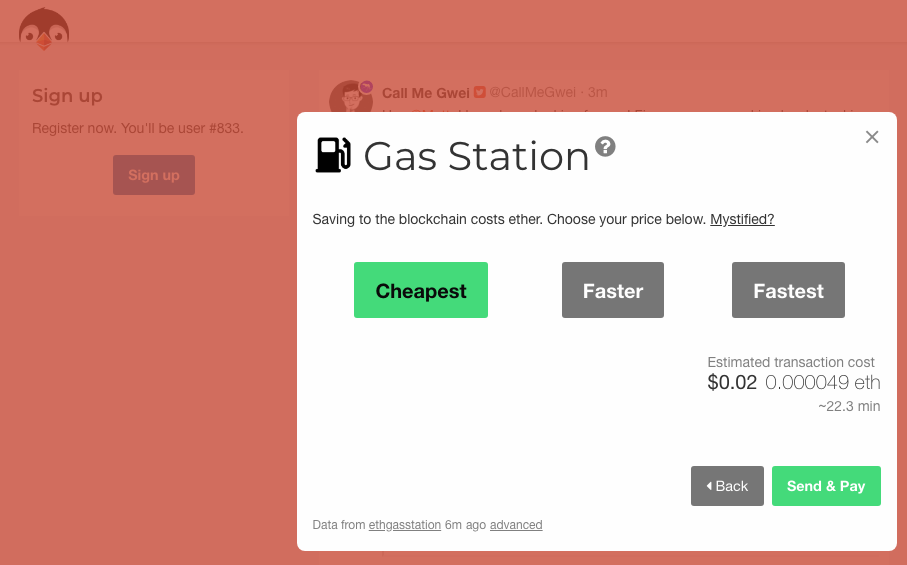It’s currently a barren landscape for DApps, with CryptoKitties still the most high profile decentralized app to have been built on a blockchain. As Chris McCann from the VC firm Greylock Partners put it, “we are orders of magnitudes away from consumer adoption of DApps.” He went on to say that “no killer app (outside of tokens and trading) have been created.”
All that is true, but there are interesting experiments happening. One of my regular lazy web requests from the blockchain developer community is a DApp version of Twitter. As I’ve pointed out before, Twitter is the quintessential Web 2.0 company – in that at first Twitter welcomed third party developers, then royally screwed them. A decentralized version of Twitter would prevent a centralized company, like Twitter Corp, from treating developers and users with such disdain again.
Enter Peepeth, which went live at the end of last month as a “decentralized microblogging site.” I signed up and became user #833. Here’s what I’ve discovered so far…
To sign up for Peepeth, you first need to enter your email address to request an invite. But mine came through within an hour or two, so go ahead and request an invite to try this site out for yourself.
The first thing you realise when you sign up to Peepeth, is that you need to pay to create a profile. But before you close your browser tab in disgust, note that it only costs about $0.02. This is to save your profile to the Ethereum blockchain.

While the cost is literally a micropayment, the process of signing up to Peepeth is likely to intimidate casual users who aren’t used to blockchain DApps. That’s because you have to install an app called MetaMask – “so your browser can talk to the blockchain” – and then either buy some Ether or transfer Ether from one of your digital wallets.
MetaMask is a kind of bridge between your browser and the Ethereum blockchain, but it’s a confusing app when you first encounter it. If you’re a Chrome user, you can install MetaMask as an add-on. When you first open it, an animated fox icon pops up in your browser and follows your cursor around the screen with its eyes. If your experience is anything like mine, you’ll initially be bewildered with the animated fox and the hard to decipher user interface. But eventually you’ll work out that you need to connect MetaMask to the “Main Ethereum Network.”
After you’re successfully connected, you need to either buy or transfer some ETH in order to create a Peepeth profile. I transferred about $10 worth of ETH into a wallet address generated by MetaMask.
Once I started using Peepeth, I realised that it costs a tiny amount every time you do something on the site. In particular, you’ll notice these micro-transactions when you follow people and post a “peep.” However, Peepeth allows you to “bulk-save actions to the blockchain.” So you won’t have to pony up ETH until you’ve done 15 actions. Once I’d gotten to my first 15 actions, I saved them to the blockchain and it cost me $0.01.
So with Peepeth, you’re literally “putting your two cents in” when you share your opinions online.

As I write this, Peepeth has only been live for less than a month and has a little under 1,000 users. Its creator, Bevan Barton, announced the site on Twitter at the end of March, so it’s very early days. When he posted his new app to ProductHunt, Barton described Peepeth as “uncensorable” and invoked freedom of speech as a feature. “No company controls your data (which is saved to the blockchain) and anybody can build a front-end that reads from and writes to the smart contract,” Barton wrote.
Also interesting to note that Peepeth was bootstrapped and did not do an ICO. Barton isn’t running any ads either, so is currently reliant on tips and donations.
How Peepeth works
Peepeth is described as “an open-source smart contract running on the Ethereum blockchain (data storage).” The user interface, currently the Peepeth.com website, is not open source. However, this just means that app developers can create their own interface to Peepeth – just like Twitter in the early days. The difference of course is that Peepeth doesn’t own the data, so they can’t cut those third party apps off at a later date.
Also noteworthy is that peeps (i.e. the content) aren’t saved to the blockchain itself, but to a decentralized data store called the Interplanetary File System (IPFS). This is the same system that Filecoin, a kind of Amazon S3 for blockchain, uses. In the case of Peepeth, what’s saved to the blockchain is simply a link to the data on IPFS. That’s the reason why ETH fees are so low in Peepeth.
So what’s the point of using the blockchain at all? It’s because “the blockchain provides a guarantee of who posted something when, and ties together all the data in one location.”
Conclusion
It’s far too early to tell if Peepeth will ramp up beyond its current three-figure user base. New social networks come and go all the time and getting users to stick around is not easy. I’ve been guilty of excitedly joining new Twitter competitors before and then abandoning them after a few weeks (sorry Mastodon).
It’ll also be a challenge to convince people to pay for a version of Twitter, even if the amounts are minuscule. Plus the MetaMask payment interface takes some getting used to.
I wish Peepeth all the best and I’ll continue to test it out in the coming weeks. I’m @ricmac on Peepeth, if you’d like to connect and give me a reason to use it!
Postscript, April 25, 2018
The day after this post was published, I locked myself out of my Peepeth account and now cannot get back in. This was caused by a mistake I made using MetaMask. I had inadvertently created more than one MetaMask wallet and neglected to back up the correct one. This not only means I lost the ETH I had transferred to that account (fortunately only about $10 worth), but I now cannot log back into my Peepeth account.
This illustrates both the user interface issues with MetaMask and the dangers of creating a blockchain version of Twitter. Once you lose your login, there’s no centralized service to reset it. The people from MetaMask and Peepeth tried to help me out, but to no avail.


also check dock.io in the decent soc network space. getting some traction apparently